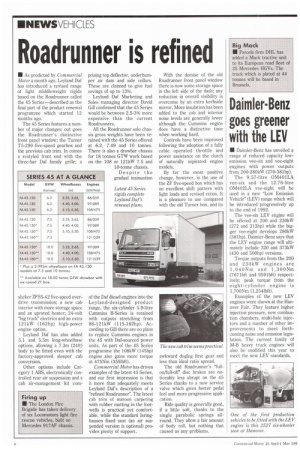Roadrunner is refined
Page 10

If you've noticed an error in this article please click here to report it so we can fix it.
• As predicted by Commercial Motor a month ago, Leyland Daf has introduced a revised range of light middleweight rigids based on the Roadrunner called the 45 Series-described as the final part of the product renewal programme which started 12 months ago.
The 45 Series features a number of major changes: out goes the Roadrunner's distinctive front panel window; the Turner T5-290 five-speed gearbox and the previous cab trim. In comes a restyled front end with the three-bar Daf family grille; a slicker ZFS5-42 five-speed overdrive transmission; a new cab interior with more storage space and an uprated heater; 24-volt "big truck" electrics and an extra 121kW (162hp) high-power engine option.
Leyland Daf has also added 5.1 and 5.5m long-wheelbase options, allowing a 7.3m (24ft) body to be fitted even with the factory-approved sleeper cab conversion.
Other options include Category 1 ABS, electronically controlled rear air suspension and a cab air-management kit corn
prising top deflector, underbumper air dam and side collars. These are claimed to give fuel savings of up to 13%.
Leyland Daf Marketing and Sales managing director David Gill confirmed that the 45 Series would be between 2.5-3% more expensive than the current Roadrunners.
All the Roadrunner solo chassis gross weights have been retained with the 45 Series offered at 6.2, 7.49 and 10 tonnes. There is also a drawbar chassis for 18 tonnes GTW work based on the 108 or 121kW 7.5 and 10-tonne chassis.
Despite the gradual insinuation of the Daf diesel engines into the Leyland-designed product range, the six-cylinder 5.9-litre Cummins B-Series is retained with outputs stretching from 86-121kW (115-162hp). According to Gill there are no plans to replace Cummins engines in the 45 with Daf-sourced power units. As part of the 45 Series programme the 108kW (145hp) engine also gains more torque at 475Nm (3551bft).
Commercial Motor has driven examples of the latest 45 Series, and our first impression is that it more than adequately meets Leyland Daf's description of a "refined Roadrunner". The latest cab trim of maroon carpeting with rubber matting in the footwells is practical yet comfortable, while the standard Isringhausen fixed seat (an air suspended version is optional) provides plenty of support. With the demise of the old Roadrunner front panel window there is now some storage space in the left side of the dash; any reduction in overall visibility is overcome by an extra kerbside mirror. More insulation has been added to the cab and interior noise levels are generally lower although the Cummins engine does have a distinctive tone when working hard.
Controls have been improved following the adoption of a fully cable operated throttle and power assistance on the clutch of naturally aspirated engine models.
By far the most positive change, however, is the use of the ZF five-speed box which has an excellent shift pattern with light loads and revised ratios. It is a pleasure to use compared with the old Turner box, and its awkward dogleg first gear and less than ideal ratio spread.
The old Roadrunner's "fullon/full-off" disc brakes are noticeably less abrupt on the 45 Series thanks to a new service valve which gives better pedal feel and more progressive application.
Ride quality is generally good, if a little soft, thanks to the single parabolic springs allround. They allow a fair amount of body roll, but nothing that caused us any problems.
























































































































